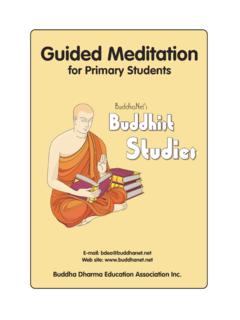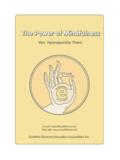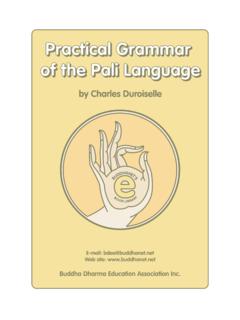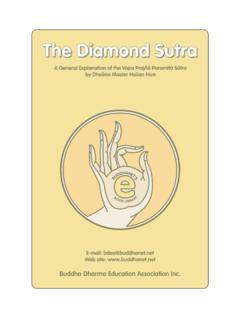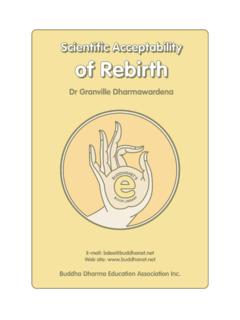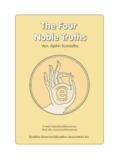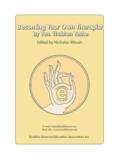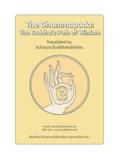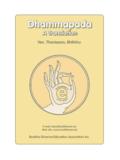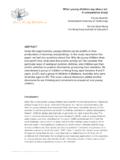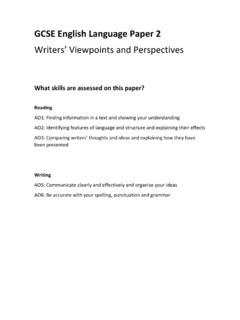Transcription of The Tree of Enlightenment - Buddhism
1 The tree of Enlightenment Dr Peter Della Santina e DHANET. UD '. B. S. BO Y. O K LIB R A R. E-mail: Web site: Buddha Dharma Education Association Inc. Peter Della Santina he ree of nlightenment n ntroduction to the ajor raditions of uddhism Chico Dharma Study Foundation . Copyright by Peter Della Santina CONTENTS. About the Author .. viii Author's Note .. x Part One he undamentals of uddhism Chapter One Buddhism : A Modern . Chapter Two e Pre-Buddhist Background .. Chapter ree e Life of the Buddha .. Chapter Four e Four Noble Truths .. Chapter Five Morality .. Chapter Six Mental Development .. Chapter Seven . Chapter Eight Karma .. Chapter Nine.
2 Chapter Ten Interdependent Origination .. iv Chapter Eleven e ree Universal Characteristics .. Chapter Twelve e Five Aggregates .. Chapter irteen e Fundamentals in Practice .. Part Two he ahayana Chapter Fourteen e Origins of the Mahayana Tradition .. Chapter Fifteen e Lotus Sutra .. Chapter Sixteen e Heart Sutra .. Chapter Seventeen e Lankavatara Sutra .. Chapter Eighteen e Philosophy of the Middle . Chapter Nineteen e Philosophy of Mind . Chapter Twenty e Development of Mahayana . Chapter Twenty-One Mahayana Buddhism in Practice .. v Part ree he ajrayana Chapter Twenty-Two e Origins of the Vajrayana Tradition .. Chapter Twenty- ree Philosophical and Religious.
3 Chapter Twenty-Four Methodology .. Chapter Twenty-Five Myth and . Chapter Twenty-Six Psychology, Physiology, and Cosmology .. Chapter Twenty-Seven e Preliminary Practices .. Chapter Twenty-Eight e Vajrayana Initiation .. Chapter Twenty-Nine Vajrayana Buddhism in . Part Four he bhidharma Chapter irty An Introduction to the Abhidharma .. vi Chapter irty-One Philosophy & Psychology in the Abhidharma .. Chapter irty-Two Methodology .. Chapter irty- ree Analysis of Consciousness .. Chapter irty-Four e Form and Formless Spheres .. Chapter irty-Five Supramundane Consciousness .. Chapter irty-Six Analysis of Mental . Chapter irty-Seven Analysis of ought-Processes.
4 Chapter irty-Eight Analysis of Matter .. Chapter irty-Nine Analysis of Conditionality .. Chapter Forty e irty-Seven Factors of Enlightenment .. Chapter Forty-One Abhidharma in Daily Life .. vii bout the uthor P eter Della Santina was born in the USA. He has spent many years studying and teaching in South and East Asia. He received his BA. in religion from Wesleyan University, Middletown, Connecticut, USA in and a MA in philoso- phy from the University of Delhi, India two years later. He did his in Buddhist Studies also from the University of Delhi, India in . He worked for three years for the Institute for Advanced Studies of world Religions, Fort Lee, New Jersey as a research scholar translating th century Buddhist philosophical texts from the Tibetan.
5 He taught at several Universities and Buddhist cen- ters in Europe and Asia including, the University of Pisa in Italy, the National University of Singapore and Tibet House in Delhi, India. He was the Coordinator of the Buddhist Studies pro- ject at the Curriculum Development Institute of Singapore, a department of the Ministry of Education from to . More recently, he was a senior fellow at the Indian Institute of Advanced Study, Simla, India and taught Philosophy at the Fo Kuang Shan Academy of Chinese Buddhism , Kaoh-shiung, Taiwan. For twenty-five years Peter Della Santina has been a student of Sakya Trizin, leader of the Sakya Order of Tibetan Buddhism and of eminent abets of the Sakya Tradition.
6 He has practiced Buddhist meditation and has completed a num- ber of retreats. viii He has published several books and articles in academic journals including Nagarjuna's Letter to King Gautamiputra, Delhi and and Madhyamaka Schools In India, Delhi and the Madhyamaka and Modern Western Philosophy, Philosophy East and West, Hawaii, .. ix uthor's ote F rom to when I was in Singapore engaged in the Buddhist studies project at the Curriculum Development Institute, I was invited by the Srilankaramaya Buddhist Temple and a number of Buddhist friends to deliver four series of lec- tures covering some of the major traditions of Buddhism . e lectures were popular, and thanks to the efforts of Mr.
7 Yeo Eng Chen and others, they were recorded, transcribed and printed for limited free distribution to students of the Dharma. In the years since, the lectures which originally appeared in the form of four separate booklets have remained popular and have even been reprinted from time to time. Consequently, it seemed to me to be desirable to collect the four series of lectures in one vol- ume, and after appropriate revision to publish them for the gen- eral use of the public. In keeping with the original objectives of the lectures, this book is as far as possible non-technical. It is intended for ordi- nary readers not having any special expertise in Buddhist stud- ies or in Buddhist canonical languages.
8 Original language terms have therefore been kept to a minimum and foot notes have been avoided. Names of texts cited are sometimes left untranslated, but this is because the English renderings of some titles are awk- ward and hardly make their subject matter more clear. In brief I hope that this book will serve as the beginning of its readers'. Buddhist education and not the end of it. e book can supply a general introduction to the major traditions of Buddhism , but x it does not pretend to be complete or definitive. Neither can I. honestly affirm that it is altogether free from errors, and there- fore I apologize in advance for any that may remain in spite of my best efforts.
9 A number of original language terms and personal names which have by now entered the English language such as Dharma', karma', Nirvana' and Shakyamuni' have been used throughout the book in their Sanskrit forms. As for the rest, Pali original language terms, text titles and personal names have been retained in parts I and IV which are largely based on Pali sources, while Sanskrit original language technical terms, text titles and personal names have been used in parts II and III which are largely based on Sanskrit and Tibetan sources. Occasionally, this general rule has been ignored when the names of texts and per- sons referred to in a given context actually occur in another one of the canonical languages.
10 In as much as Pali and Sanskrit are in most cases quite similar, I trust the average reader will have no difficulty in coping with this arrangement. I owe a great debt to a very large number of people for the realization of this book. First and foremost, I would like to thank Sakya Trizin without whom my interest in Buddhism might well have remained superficial and merely intellectual. Next I would like to thank Yeo Eng Chen and many other mem- bers of the Singapore Buddhist community without whose help and encouragement the lectures would never have been delivered and the original transcripts on which this book is based, never made.
